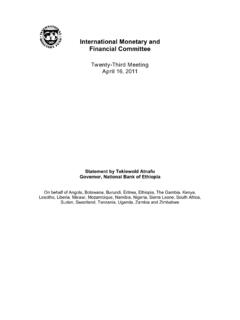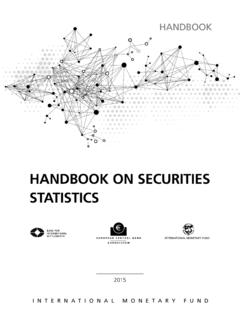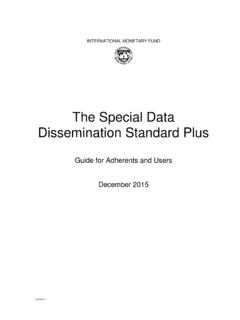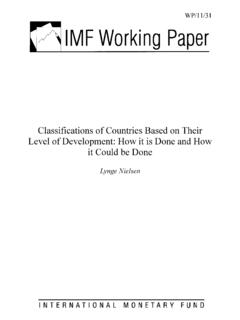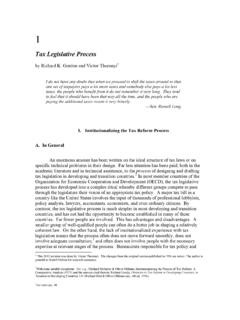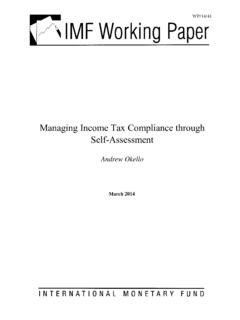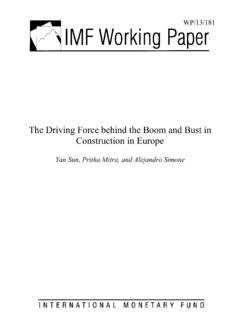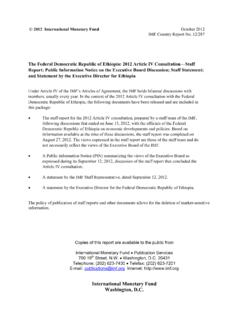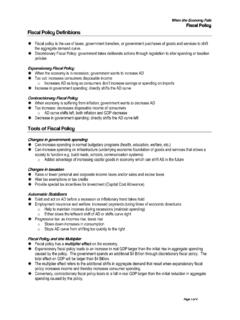Transcription of IMF POLICY PAPER - International Monetary Fund
1 IMF POLICY PAPER . fiscal POLICY AND INCOME INEQUALITY. January 23, 2014. IMF staff regularly produces papers proposing new IMF policies, exploring options for reform, or reviewing existing IMF policies and operations. The following document(s) have been released and are included in this package: The Staff Report on fiscal POLICY and Income Inequality, prepared by IMF staff and completed on January 22, 2014 to brief the Executive Board on February 7, 2014. The Executive Directors met in an informal session, and no decisions were taken at this meeting. The POLICY considerations in this PAPER should be attributed to IMF staff and not to the IMF. or its Executive Board. The analysis was prepared by the staff of the fiscal Affairs Department and has benefited from comments and suggestions by staff from other IMF departments, as well as by Executive Directors following their discussion of the report on February 7, 2014.
2 The POLICY of publication of staff reports and other documents allows for the deletion of market-sensitive information. Electronic copies of IMF POLICY Papers are available to the public from International Monetary fund Washington, 2014 International Monetary fund fiscal POLICY AND INCOME INEQUALITY. January 22, 2014. EXECUTIVE SUMMARY. fiscal POLICY is the primary tool for governments to affect income distribution. Rising income inequality in advanced and developing economies has coincided with growing public support for income redistribution. This comes at a time when fiscal restraint is an important priority in many advanced and developing economies. In the context of the fund 's mandate to promote growth and stability, this PAPER describes: (i) recent trends in the inequality of income, wealth, and opportunity in advanced and developing economies; (ii) country experience with different fiscal instruments for redistribution; (iii) options for the reform of expenditure and tax policies to help achieve distributive objectives in an efficient manner that is consistent with fiscal sustainability.
3 And (iv) recent evidence on how fiscal POLICY measures can be designed to mitigate the impact of fiscal consolidation on inequality. This PAPER does not advocate any particular redistributive goal or POLICY instrument for fiscal redistribution. Both tax and expenditure policies need to be carefully designed to balance distributional and efficiency objectives, including during fiscal consolidation. The appropriate mix of instruments will depend on administrative capacity, as well as on society's preferences for redistribution, the role envisaged for the state, and political economy considerations. Options for redistributive policies that help minimize efficiency costs, in terms of their effects on incentives to work and save, are the following: In advanced economies: (i) using means-testing, with a gradual phasing out of benefits as incomes rise to avoid adverse effects on employment; (ii) raising retirement ages in pension systems, with adequate provisions for the poor whose life expectancy could be shorter; (iii) improving the access of lower-income groups to higher education and maintaining access to health services; (iv) implementing progressive personal income tax (PIT) rate structures; and (v) reducing regressive tax exemptions.
4 In developing economies: (i) consolidating social assistance programs and improving targeting; (ii) introducing and expanding conditional cash transfer programs as administrative capacity improves; (iii) expanding noncontributory means-tested social pensions; (iv) improving access of low-income families to education and health services; and (v) expanding coverage of the PIT. Innovative approaches, such as the greater use of taxes on property and energy (such as carbon taxes) could also be considered in both advanced and developing economies. fiscal POLICY AND INCOME INEQUALITY. Approved By Prepared by staff from fiscal Affairs Department supervised by Sanjeev Gupta Sanjeev Gupta and Michael Keen, and comprising Benedict Clements, Victoria Perry, David Coady, Ruud De Mooij, Stefania Fabrizio, Baoping Shang, Allan Dizioli, Luc Eyraud, Csaba Feher, Valentina Flamini, Alvar Kangur, Javier Kapsoli, Carlos Mulas-Granados, Peter Mullins, Philippe Wingender, Dora Benedek, Ryan Espiritu, and Louis Sears.
5 Production assistance was provided by Pierre Jean Albert, Jeffrey Pichocki, and Mileva Radisavljevi . CONTENTS. INTRODUCTION _____ 4 TRENDS IN INEQUALITY_____ 7 A. Inequality of Income _____ 7 B. Inequality of Wealth _____ 11 C. Lifetime Inequality _____ 13 D. Inequality of Opportunity _____ 13 fiscal REDISTRIBUTION _____ 14 A. Advanced Economies_____ 15 B. Developing Economies _____ 18 DESIGN OF EFFICIENT REDISTRIBUTIVE fiscal POLICY_____ 21 A. Conceptual Framework _____ 21 B. Social Spending _____ 25 C. Tax Design_____ 36 D. Summary _____ 42 fiscal CONSOLIDATION AND INEQUALITY _____ 43 A. Advanced Economies_____ 44 B. Developing Economies _____ 48 Appendix I. Who Benefits from Tax Incentives for Charitable Giving?_____ 50 BOXES. 1. Efficiency and fiscal Redistribution _____ 6 2. Rising Public Support for Redistribution_____ 9 3.
6 Redistributive fiscal POLICY : Evidence from Regression Analysis _____ 15 4. fiscal POLICY and Income Inequality in Latin America _____ 19 5. What is the Shape of the Optimal Income Tax Schedule? _____ 23 2 International Monetary fund . fiscal POLICY AND INCOME INEQUALITY. 6. In-Work Benefits and Credits _____ 25 7. Conditional Cash Transfer Programs _____ 32. FIGURES. 1. Trends in Disposable Income Inequality, 1980 2010 _____ 8 2. Gross Income Share of Top One-Percent in Selected Advanced and Developing Economies, 1925 2012 _____ 10 3. Poverty Rates in Developing Economies, 1980 2010 _____ 11 4. Inequality of Wealth and Incomes in Selected Economies, early-2000s _____ 12 5. The Great Gatsby Curve: Income Inequality and Economic Mobility , mid-1980s _____ 14 6. Redistributive Impact of fiscal POLICY in Advanced Economies, mid-2000s _____ 16 7.
7 Diminishing fiscal Redistribution, 1985 2005 _____ 17 8. Tax Revenues and Social Spending in Advanced and Developing Economies _____ 19 9. Social Protection Coverage and Incidence in Developing Economies, late-2000s _____ 20 10. Benefit Incidence of Education and Health Public Spending _____ 21 11. Means-tested and Non-means-tested Family Benefits, 2010 _____ 28 12. Top PIT Rates, 1980 2012 _____ 37 13. Redistributive Effect of fiscal Adjustments, 2007 2012 _____ 45 14. Cumulative Change in Households Disposable Income due to Simulated fiscal Consolidation Measures, 2008 12 _____ 47 15. Simulated Impact of fiscal Consolidation (FC) Measures on Gini Index, 2012 _____ 47 16. Unemployment Rates and Gini Coefficients During Large fiscal Adjustments in Developing Economies _____ 48 TABLES. 1. Summary: fiscal Reform Options for Efficient Redistribution in Advanced and Developing Economies _____ 43 APPENDICES.
8 I. Who Benefits from Tax Incentives for Charitable Giving? _____ 50 II. Recent fiscal Consolidations and Income Inequality _____ 51 APPENDIX FIGURES. 1. Aggregate Effect and Composition of Simulated fiscal Consolidation Measures, 2008 12 ___ 51 2. Change in Household Disposable Income by Type of Measure and Income Group, 2007 12 _____ 53 REFERENCES_____54. International Monetary fund 3. fiscal POLICY AND INCOME INEQUALITY. INTRODUCTION. 1. Income inequality has increased in both advanced and developing economies in recent Increasing inequality has been attributed to a range of factors, including the globalization and liberalization of factor and product markets; skill-biased technological change; increases in labor force participation by low-skilled workers; declining top marginal income tax rates; increasing bargaining power of high earners; and the growing share of high-income couples and single-parent households (OECD, 2008; Alvaredo and others, 2013; Hoeller, Joumard, and Koske, 2014).
9 Many of these developments have had beneficial effects on growth and poverty reduction both nationally and globally (Chen and Ravallion, 2010; Milanovic, 2012). 2. There is growing evidence that high income inequality can be detrimental to achieving macroeconomic stability and growth. Recent empirical work finds that high levels of inequality are harmful for the pace and sustainability of growth (Ostry, Berg, and Tsangarides, forthcoming). Others have argued that rising inequality may have been an important contributing factor to the global financial Moreover, evidence from public surveys in various countries indicates that widening income inequality has been accompanied by growing public demand for income redistribution, especially in countries most strongly affected by the crisis. This comes at a time when high public debt ratios in the advanced economies, and emerging vulnerabilities in the developing economies, have made fiscal restraint an important priority, and point to the importance of sensitivity to distributional concerns in designing consolidation packages.
10 In this light, income inequality can be of macroeconomic concern for country authorities, and the fund should accordingly seek to understand the macroeconomic effects of inequality. In addition, in its POLICY advice, the fund should be mindful of how macroeconomic policies (including fiscal policies) affect income distribution and their consistency with the distributional goals of country authorities. 3. fiscal POLICY is the primary tool for governments to affect income fiscal POLICY has three main objectives to support macroeconomic stability, provide public goods and correct market failures, and redistribute income. Both tax and spending policies can alter the distribution of income, both over the short and medium term. For example, in-kind benefits, such as education spending, can affect the inequality of market incomes ( , incomes before taxes and transfers) through their impact on future earnings.
